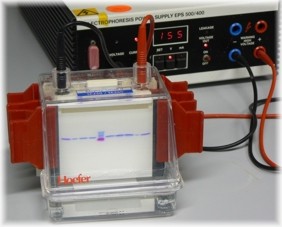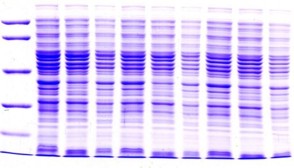 One of the most widespread techniques in modern biochemistry, molecular biology, clinical chemistry etc. is electrophoresis on polyacrylamide (or other) gels. In this procedure, a mixture of substances, typically proteins or peptides, in a biological sample are separated by virtue of differential mobility in an electrical field. Often a detergent is used, in which case molecules separate according to their size. For this method to be useful it is necessary to reveal the (usually colourless) separated protein bands.
One of the most widespread techniques in modern biochemistry, molecular biology, clinical chemistry etc. is electrophoresis on polyacrylamide (or other) gels. In this procedure, a mixture of substances, typically proteins or peptides, in a biological sample are separated by virtue of differential mobility in an electrical field. Often a detergent is used, in which case molecules separate according to their size. For this method to be useful it is necessary to reveal the (usually colourless) separated protein bands.
 Typically, for this purpose, the electrophoresis gels are stained with dyes followed by a further lengthy de-staining step in a potentially harmful methanol-acetic acid mixture to remove excess dyes from the gel. Used de-staining solutions (typically approximately 1-2 litres) can be recycled. However, this procedure requires expensive cartridges or columns to remove the dyes. Usually in research laboratories, instead of columns or cartridges, simple funnels are used, filled with activated charcoal. However, this requires a fume hood to remove the harmful vapours.
Typically, for this purpose, the electrophoresis gels are stained with dyes followed by a further lengthy de-staining step in a potentially harmful methanol-acetic acid mixture to remove excess dyes from the gel. Used de-staining solutions (typically approximately 1-2 litres) can be recycled. However, this procedure requires expensive cartridges or columns to remove the dyes. Usually in research laboratories, instead of columns or cartridges, simple funnels are used, filled with activated charcoal. However, this requires a fume hood to remove the harmful vapours.
We have developed and patented a novel de-staining device, which comprises a closed container including dye absorbent trapped in a solid matrix, which covers the bottom of the container. This absorbent will remain at the bottom of the container and will capture any excess dye diffused from the electrophoresis gels during the de-staining process.
Products & Services
Website supported by







